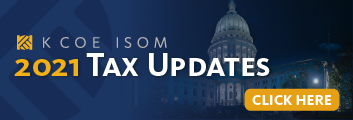On August 10, 2021, the Senate passed its infrastructure package detailing the federal government’s investments in America’s roads, rails, waterways, and communications systems. Among the provisions that have been slated to pay for these investments is an early end to the historic Employee Retention Tax Credit (ERTC).
Under current law, the pandemic-related tax credit for wages paid to employees of a business affected by COVID-19 is set to end on December 31, 2021. If approved by the House, the credit would expire on September 30, 2021, a full calendar quarter early.
New ‘Gross Receipt’ and Safe Harbor Guidelines Announced
Additionally, the IRS introduced key guidance on what constitutes “gross receipts” – effective immediately.
The ERTC is available for employers who experience a “significant decline in gross receipts” in any one or more calendar quarter. The IRS has enacted a “safe harbor” in Revenue Procedure 2021-33, providing that employers may exclude:
- Any Paycheck Protection Program (PPP) loan forgiveness
- Shuttered Venue Operators Grants
- Restaurant Revitalization Grants
Employers using the safe harbor may choose to exclude these amounts only for determining whether it is an eligible employer for purposes of claiming the ERTC; and if it does exclude these amounts, it must do so uniformly, both throughout all calendar quarters in which gross receipts are relevant to calculating eligibility, and to all related employers.
KCoe Pro Takeaway: While the gross receipt guidelines may now allow some additional employers to be eligible for the credit (who didn’t previously qualify), this should be fully evaluated by a professional advisor as the potential for benefits will vary on a case-by-case basis.
Should you have any questions regarding the impacts these changes could have on your tax plan and strategy, contact a KCoe tax advisor or click the button below.










